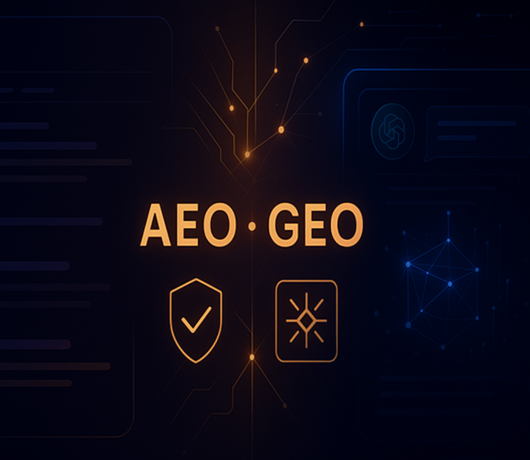Optimizing for AI Search: How HubSpot Empowers AEO and GEO Strategies
Search has evolved more in the past two years than in the entire previous decade. What was once a game of keywords and backlinks is now a complex ecosystem driven by user intent, context, and AI-powered understanding. Today, users expect instant, conversational answers from platforms like ChatGPT, Gemini, and Perplexity, rather than a static list of links. Search visibility no longer only means being on the first page—it’s about becoming part of the answers themselves.
This shift has given rise to two new disciplines: Answer Engine Optimization (AEO) and Generative Engine Optimization (GEO). Both reflect the move from optimizing for traditional search engines to optimizing for AI-driven “answer engines,” where algorithms quickly synthesize and deliver information.
For organizations, this change presents both an opportunity and a challenge. How do you ensure your expertise is cited when users never see your website? How do you position your brand’s authority when AI decides which voices to trust?
To succeed in this new environment, marketers and content strategists must understand how these engines interpret, select, and represent expertise.

Understanding AEO and GEO: What They Are and How They Differ
The AI transformation of information discovery has elevated both AEO and GEO as pillars of digital visibility:
-
Answer Engine Optimization (AEO) focuses on getting your content selected as direct answers within search engines. This manifests as featured snippets on Google, “People also ask” boxes, and answers from voice assistants like Siri and Alexa. AEO is all about structure, authority, and clarity—it ensures search engines can quickly display your content as the most credible and precise answer.
-
Generative Engine Optimization (GEO) is about influencing how generative AI tools (such as ChatGPT, Gemini, and Perplexity) find and blend your content when composing conversational answers. Unlike traditional search, these tools generate new, synthesized responses by combining content from multiple trusted sources. To be included, your material must be deep, well-contextualized, and highly credible.
Simply put:
- AEO helps your content appear as a direct answer in traditional search.
- GEO helps your expertise surface within AI-generated, conversational responses.
As the boundaries between these approaches continue to evolve, one thing is certain—being visible now means being recognized for knowledge, not just for links or keywords.
Search and Brand Visibility in the AI Era
The measures of visibility online are being rewritten. Where SEO was once about page-one rankings, the challenge is now to be cited—or even paraphrased—by search and AI systems that determine which content and which brands are trustworthy and relevant.
Here’s what now matters most:
- Authority and Expertise Over Volume - Modern AI and search platforms increasingly favor depth and credibility. Instead of many shallow blog posts, a few authoritative, well-structured pieces carry more weight. The E-E-A-T framework (Experience, Expertise, Authoritativeness, Trust) remains central to how both search engines and AI models rank and present information.
- Structured, Machine-Readable Content - Clear hierarchical headings, schema markup, and organized Q&A formats make content easier for both users and algorithms to interpret. Structured content allows engines to understand your intent and context, resulting in higher inclusion in both search features and AI responses.
- Contextual and Semantic Depth - With the aid of internal linking, topic clusters, and related thematic narratives, organizations can build a “semantic fingerprint” that clarifies their expertise for answer engines. This interconnected web of content strengthens both AEO and GEO outcomes.
- Brand Consistency Across Channels - Today’s algorithms look beyond single websites for consistent signals. Mentions, citations, and expert contributions across social media, guest publishing, and partners collectively define what your brand represents and reinforce trust for AI systems.
- Continuous Learning and Optimization - Both search and AI-driven systems are dynamic, requiring ongoing analysis and adaptation. Monitoring performance, reviewing how your brand is surfaced in AI outputs, and adjusting strategies accordingly is now a regular part of effective digital visibility.

Ultimately, standing out in the AI era is less about gaming the system and more about teaching algorithms what your brand stands for and why it’s a trusted voice.
How HubSpot Helps You Prepare for AEO & GEO
Organizations facing the shift toward AI-driven search need practical, accessible tools to adapt and thrive. HubSpot offers a robust suite designed to support both AEO and GEO strategies, making it possible to go beyond legacy SEO into truly modern, answer-focused optimization.
AEO Grader
 HubSpot’s free AEO Grader lets marketers assess how their content is picked up by both traditional search engines and generative AI platforms. It highlights your brand’s mentions, relevance, and authority signals, showing exactly where you may be overlooked and how you can improve.
HubSpot’s free AEO Grader lets marketers assess how their content is picked up by both traditional search engines and generative AI platforms. It highlights your brand’s mentions, relevance, and authority signals, showing exactly where you may be overlooked and how you can improve.
Actionable Insights and Content Strategy
Insights from the AEO audit can be used to close content gaps, strengthen topic clusters, and strategically boost your authority. HubSpot provides the tools to analyze, prioritize, and implement recommendations that will help your expertise surface more frequently in both search and conversational answers.
HubSpot AEO Strategy Tool (Beta)
Within its next-generation toolkit—currently in limited beta—HubSpot introduces new capabilities including:
- AI Referral Monitoring: Track site traffic, engagement, and conversions originating from AI platforms.
- Share of Voice and Brand Sentiment: Measure the frequency and context in which your brand appears in AI-generated responses, and benchmark this performance against competitors.
- Competitive Positioning: Visualize your standing in the AI-fueled ecosystem and identify specific opportunities to strengthen your visibility.
- Actionable Recommendations: Receive tailored recommendations for optimizing every asset—text, video, or visual—to maximize impact across engines.
These features enable practitioners to continuously refine their approach, ensuring sustained authority and relevance as algorithms evolve.
More HubSpot Tools for AEO and GEO Optimization
Expanding on foundational AEO and GEO strategies, HubSpot’s ecosystem offers a comprehensive suite of features that enable ongoing success:
AI-Powered Content Creation and Optimization
HubSpot’s Content Hub is now equipped with integrated AI—such as the Breeze content assistant—that can draft, expand, and adapt copy for both clarity and conversational tone. Automated SEO recommendations (including schema, headings, and intent-focused optimization) help ensure every asset is ready for both search and AI engine consumption.
Topic Clustering and Content Authority
The Topic Cluster tool enables you to organize and visualize your content around core “pillar” topics and supporting subtopics. This structured approach, favored by both traditional engines and generative AI, helps your expertise be recognized within larger thematic conversations. Automated internal linking suggestions deepen those contextual signals, further strengthening authority.
Advanced Analytics, Attribution, and Continuous Improvement
HubSpot connects analytics, behavioral data, and customizable dashboards—not just to monitor SEO metrics, but also to track nuanced engagement and attribution (e.g., brand mentions within answer engines or AI-driven platforms). Marketers can then identify which content drives influence, iterate based on data, and keep pace with new optimization standards.
Conversational Intelligence and Real-Time Insights
With tools like ChatSpot, HubSpot makes it easier to analyze conversational and AI-powered interactions, surfacing the latest user questions and feedback trends. This intelligence exposes new content opportunities, reveals gaps, and helps marketers respond to emerging queries in real time.
Personalization, Automation, and Behavioral Targeting
HubSpot’s CRM-driven personalization—using dynamic content blocks, smart CTAs, and automated workflows—equips marketing teams to deliver timely, relevant answers matched to real user intent. This responsiveness directly supports strong GEO optimization.
Extensibility and Marketplace Integrations
The HubSpot App Marketplace offers an array of AI, SEO, and syndication integrations—enabling automation of structured data, web presence monitoring, and syndication of expertise across multiple digital channels and answer engines. Webhook and API access allow for scalable distribution, as new platforms and engines emerge.
Recent AI Innovations
HubSpot’s evolving platform now supports:
- Content Remixing & Multilingual AI: Automatic repurposing for diverse channels (blog, video, social), as well as translation/localization for international visibility.
- Real-Time Optimization Signals: Monitor your “answer engine presence,” receive live improvement suggestions, and ensure your authority footprint grows wherever users are searching or asking.
The Big Picture: Adaptive, AI-Era Marketing
AI-driven search means marketing is no longer linear. HubSpot supports a feedback-based growth model where every customer interaction—across channels, content, and conversations—creates insights for further optimization. Express brand identity in ways machines understand, tailor messages with unified data, amplify across next-gen channels, and continually evolve tactics using performance analytics.
Conclusion
AI-driven search and generative engines are redefining what it means to be visible. It’s not enough to rank well; brands must become part of the answers that users receive from both search engines and AI. By leveraging structured content, topic authority, advanced analytics, and continuous improvement—supported by tools like HubSpot—marketing teams can audit their current visibility and actively optimize for the new era.
Ultimately, online success is shifting from chasing clicks and rankings to teaching AI systems to recognize expertise, context, and trust. With the right strategy, technology, and commitment to ongoing learning, brands can transform this challenge into a lasting advantage: being cited, trusted, and surfaced wherever audiences look for answers.



